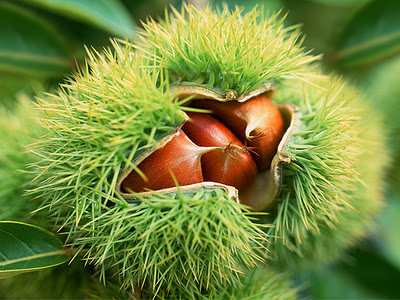 It’s that time of the season where the roads and paths are littered with browned leaves and twigs, the sky is largely grey and there’s a new, chilly wind which bites at your fingers – Autumn has arrived.
It’s that time of the season where the roads and paths are littered with browned leaves and twigs, the sky is largely grey and there’s a new, chilly wind which bites at your fingers – Autumn has arrived.
But before you sulk and mourn for summer, take a harder look at the ground next time you walk through a rural area and notice the treasures the season has brought for us. I speak of course of those spiky green balls which will soon plummet to the ground from the tree tops, our old friend the chestnut.
Chestnuts ripen around October – November and can be enjoyed raw, roasted and used as ingredients in various delicious dishes.
If ever you should fancy a little natural nibble whilst walking in the wilderness, ensure that the chestnut is good, firm and healthy looking before peeling back the brown skin, revealing creamy greenish flesh. Raw chestnut flesh has the texture of a carrot and tastes a little bit like a nutty pea with a slightly smokey aftertaste.
If you’re looking for a more traditional and less Bear Grylls approach to enjoying our favourite wild nut, then collecting a pocketful ready to roast at home is a classical option. Roasting chestnuts around an open fire has been a winter past time going back centuries. So whether you just want a tasty treat or fancy reminiscing your time with the scouts, here’s how to roast a chestnut, the sensible, indoor way.
- Preheat your oven to 400ºF (205ºC).
- Using a sharp knife, carefully cut an ‘x’ into the nuts to allow steam to escape.
- Spread the nuts across a rimmed baking sheet with their cut side up, and slide directly into the oven.
- Now you have fifteen to twenty minutes to wait. Make a cuppa or pour some scotch and ready a hot towel and a large bowl. Ensure that the nuts don’t burn by moving them frequently.
- After 20 minutes, wrap the chestnuts in a hot towel and squeeze them in order to loosen the skins. Leave wrapped in towel for five minutes.
- Now, take a chestnut and peel the skin while the nut is still warm.
- Take a bite and enjoy the warm, nutty goodness.
Best of all, unlike other nuts, chestnuts are low in saturated fat, so that’s at least one guilt-free winter indulgence.
–
Kathryn works on the marketing team and spends most of her time making our website read better.
She has a degree in English & Creative Writing and loves classic cars, 1970s music and ginger beer.
She writes our fictional stories and seasonal posts.